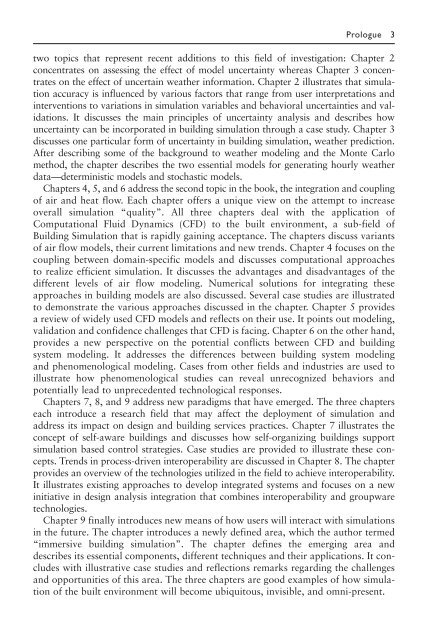Advanced Building Simulation
Advanced Building Simulation
Advanced Building Simulation
You also want an ePaper? Increase the reach of your titles
YUMPU automatically turns print PDFs into web optimized ePapers that Google loves.
Prologue 3<br />
two topics that represent recent additions to this field of investigation: Chapter 2<br />
concentrates on assessing the effect of model uncertainty whereas Chapter 3 concentrates<br />
on the effect of uncertain weather information. Chapter 2 illustrates that simulation<br />
accuracy is influenced by various factors that range from user interpretations and<br />
interventions to variations in simulation variables and behavioral uncertainties and validations.<br />
It discusses the main principles of uncertainty analysis and describes how<br />
uncertainty can be incorporated in building simulation through a case study. Chapter 3<br />
discusses one particular form of uncertainty in building simulation, weather prediction.<br />
After describing some of the background to weather modeling and the Monte Carlo<br />
method, the chapter describes the two essential models for generating hourly weather<br />
data—deterministic models and stochastic models.<br />
Chapters 4, 5, and 6 address the second topic in the book, the integration and coupling<br />
of air and heat flow. Each chapter offers a unique view on the attempt to increase<br />
overall simulation “quality”. All three chapters deal with the application of<br />
Computational Fluid Dynamics (CFD) to the built environment, a sub-field of<br />
<strong>Building</strong> <strong>Simulation</strong> that is rapidly gaining acceptance. The chapters discuss variants<br />
of air flow models, their current limitations and new trends. Chapter 4 focuses on the<br />
coupling between domain-specific models and discusses computational approaches<br />
to realize efficient simulation. It discusses the advantages and disadvantages of the<br />
different levels of air flow modeling. Numerical solutions for integrating these<br />
approaches in building models are also discussed. Several case studies are illustrated<br />
to demonstrate the various approaches discussed in the chapter. Chapter 5 provides<br />
a review of widely used CFD models and reflects on their use. It points out modeling,<br />
validation and confidence challenges that CFD is facing. Chapter 6 on the other hand,<br />
provides a new perspective on the potential conflicts between CFD and building<br />
system modeling. It addresses the differences between building system modeling<br />
and phenomenological modeling. Cases from other fields and industries are used to<br />
illustrate how phenomenological studies can reveal unrecognized behaviors and<br />
potentially lead to unprecedented technological responses.<br />
Chapters 7, 8, and 9 address new paradigms that have emerged. The three chapters<br />
each introduce a research field that may affect the deployment of simulation and<br />
address its impact on design and building services practices. Chapter 7 illustrates the<br />
concept of self-aware buildings and discusses how self-organizing buildings support<br />
simulation based control strategies. Case studies are provided to illustrate these concepts.<br />
Trends in process-driven interoperability are discussed in Chapter 8. The chapter<br />
provides an overview of the technologies utilized in the field to achieve interoperability.<br />
It illustrates existing approaches to develop integrated systems and focuses on a new<br />
initiative in design analysis integration that combines interoperability and groupware<br />
technologies.<br />
Chapter 9 finally introduces new means of how users will interact with simulations<br />
in the future. The chapter introduces a newly defined area, which the author termed<br />
“immersive building simulation”. The chapter defines the emerging area and<br />
describes its essential components, different techniques and their applications. It concludes<br />
with illustrative case studies and reflections remarks regarding the challenges<br />
and opportunities of this area. The three chapters are good examples of how simulation<br />
of the built environment will become ubiquitous, invisible, and omni-present.

















